Abstract
Objective:
To assess the effects of eccentric work-induced hamstring fatigue on sagittal and transverse plane (axial) knee and ankle biodynamics and kinetics during a running crossover cut directional change (functional pivot shift).
Design and Setting:
A pretest-posttest, single-group intervention experimental design was employed. All data were collected in a biodynamics laboratory.
Subjects:
Twenty healthy athletic females were trained for 3 weeks in crossover cutting before testing.
Measurements:
Data were sampled during 3 unfatigued and 3 fatigued (20% eccentric isokinetic knee-flexor torque reduction) crossover cut trials. Three-dimensional kinematic and ground reaction-force data were sampled at 200 Hz and 1000 Hz, respectively, and joint moment estimates were calculated. Data were standardized to initial force-plate heelstrike for comparisons of mean differences between conditions using paired t tests with Bonferroni adjustments. Pearson product-moment correlations compared kinematic and eccentric hamstring-torque relationships.
Results:
During internal rotation phase 1, between heelstrike and impact absorption, mean internal rotation velocity increased by 21.2°/s ± 114°/s. During internal rotation phase II, mean peak transverse plane knee rotation during propulsion decreased by 3.1° ± 9°. During internal rotation phase II, mean peak ankle plantar flexor moment onsets occurred 12.7 ± 53 milliseconds earlier, and this activation demonstrated a moderately positive relationship with the onset of mean peak knee internal rotation during propulsion and a weak negative relationship with mean peak hamstring torque/lean body weight.
Conclusions:
The increased knee internal rotation velocity during phase I indicates transverse plane dynamic knee-control deficits during hamstring fatigue. Earlier peak ankle plantar-flexor moments and decreased internal rotation during phase II in the presence of hamstring fatigue may represent compensatory attempts at dynamic knee stabilization from the posterior lower leg musculature during the pivot shift portion of the crossover cut. The weak relationship between decreased hamstring torque/lean body weight and delayed knee internal rotation during propulsion further supports greater dependence on ankle plantar flexors for dynamic knee stabilization compensation
Keywords: biomechanics, injury mechanisms, functional movement assessment
Full text
PDF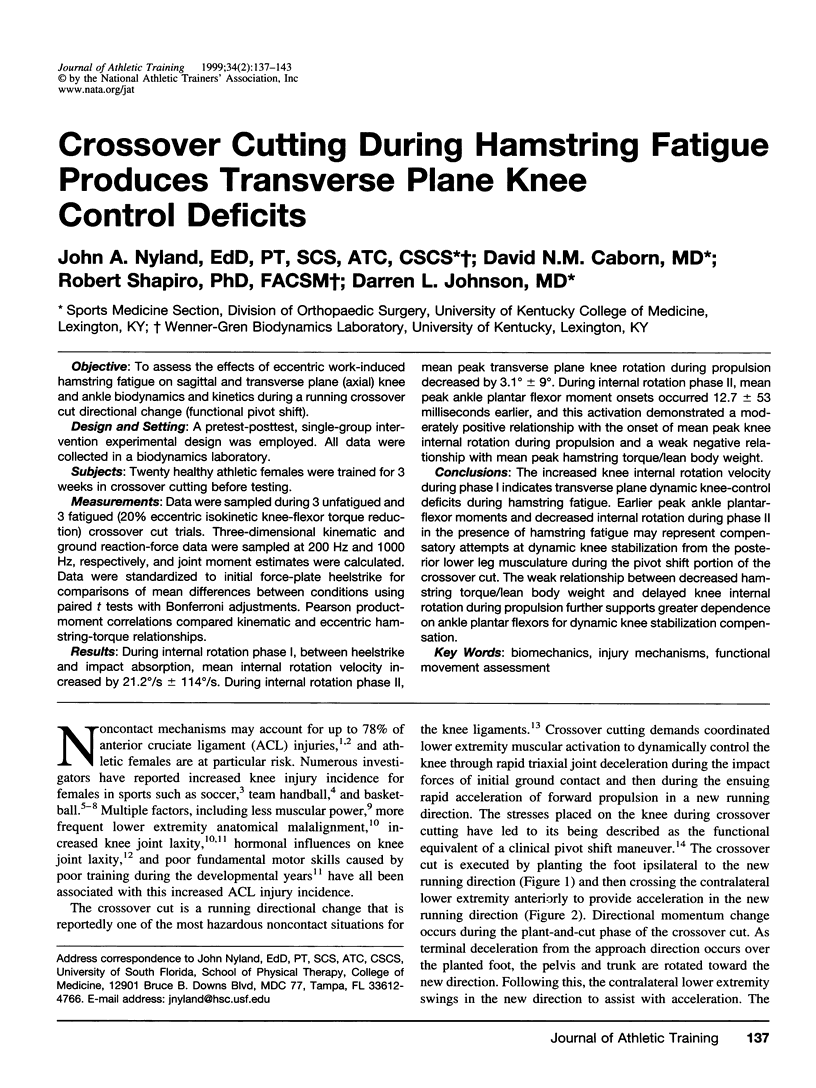
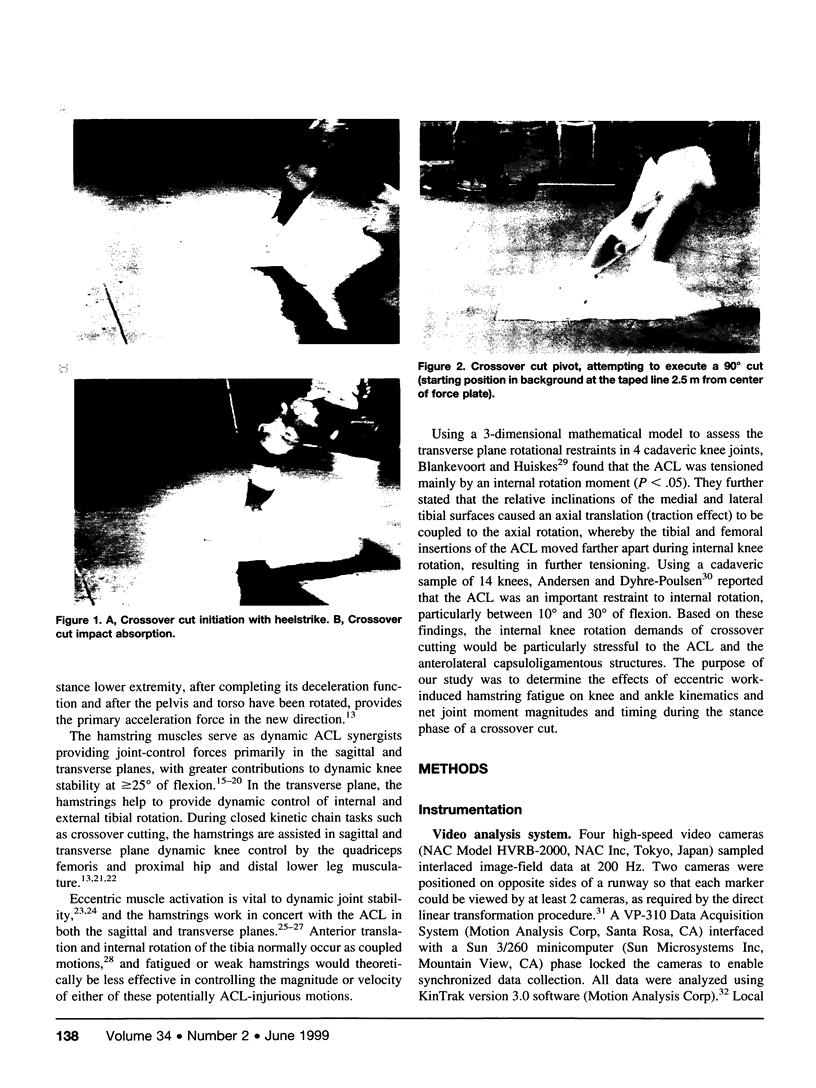
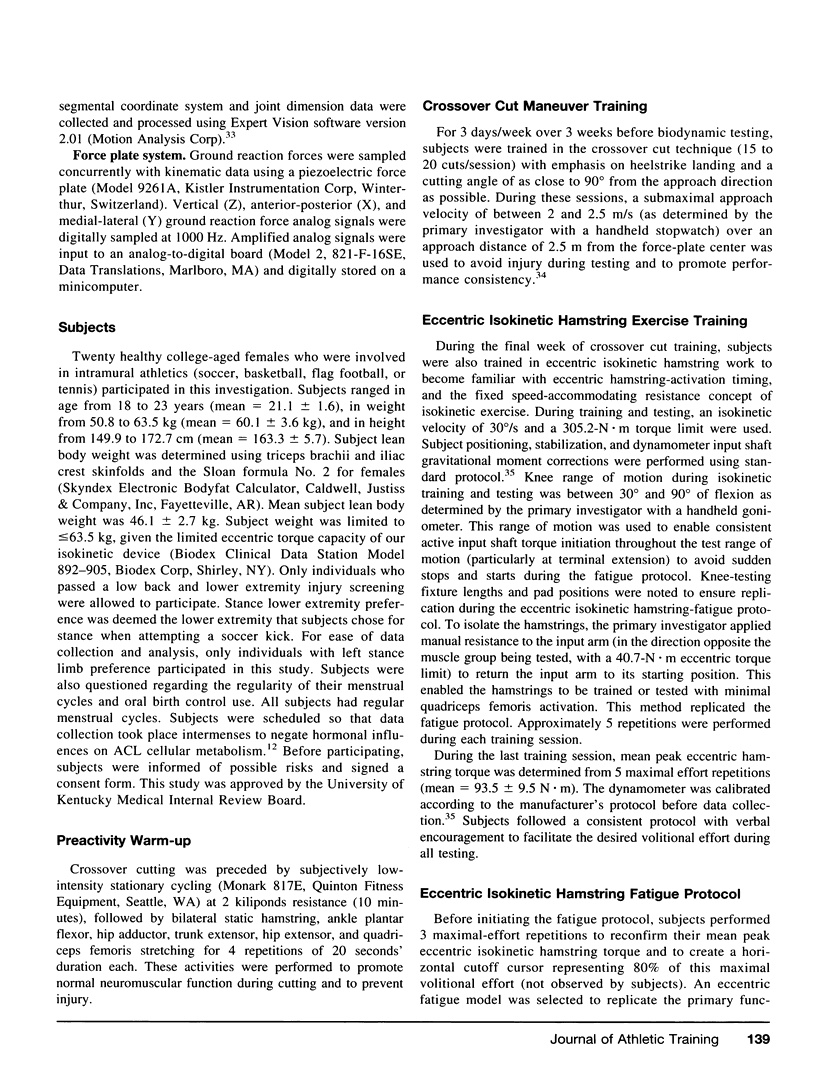
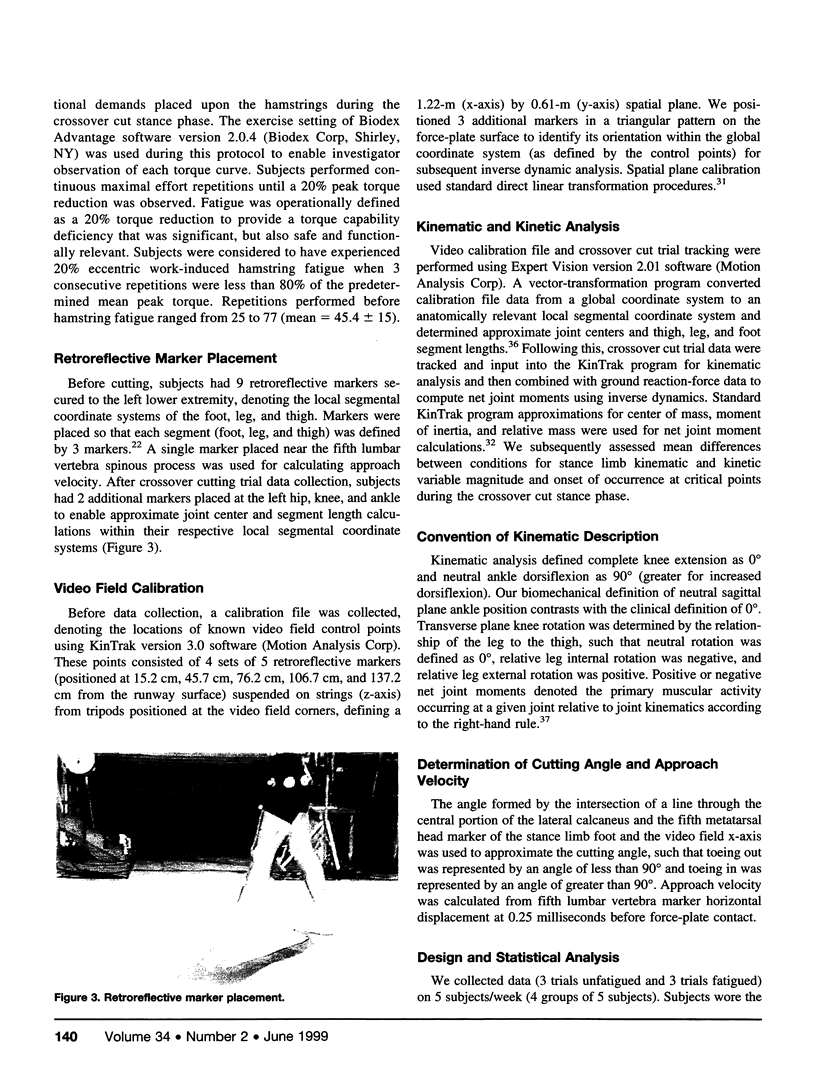
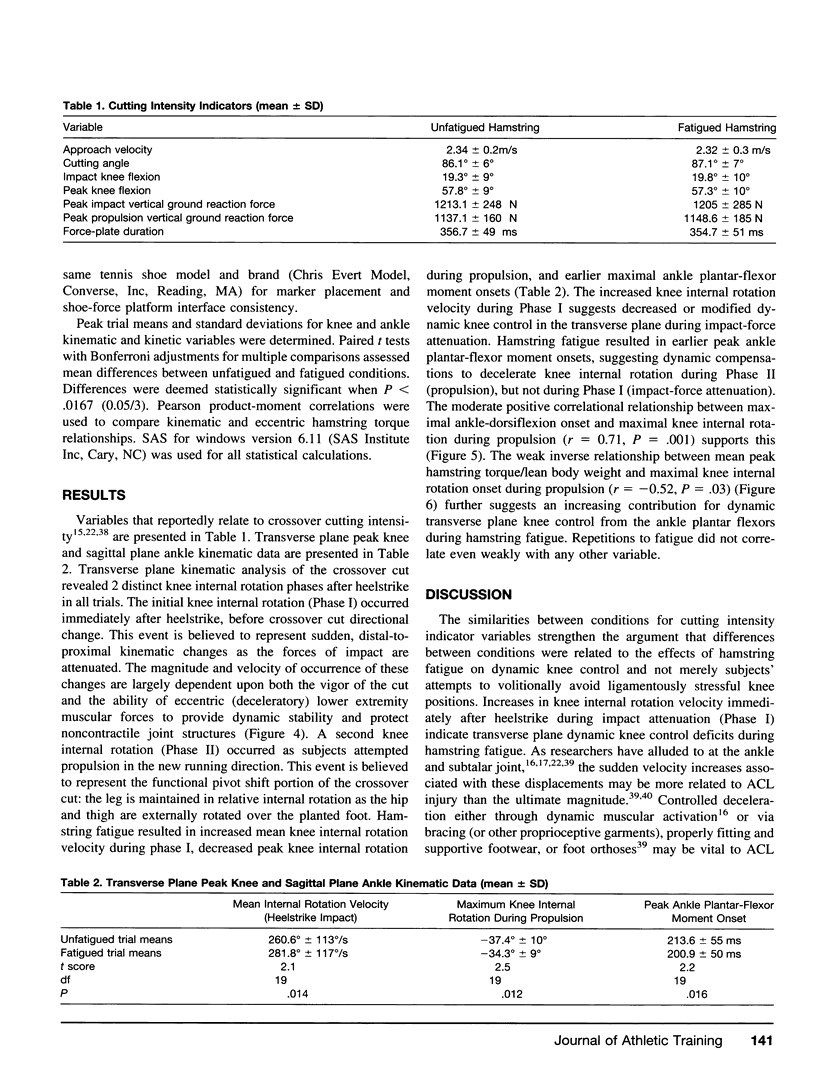

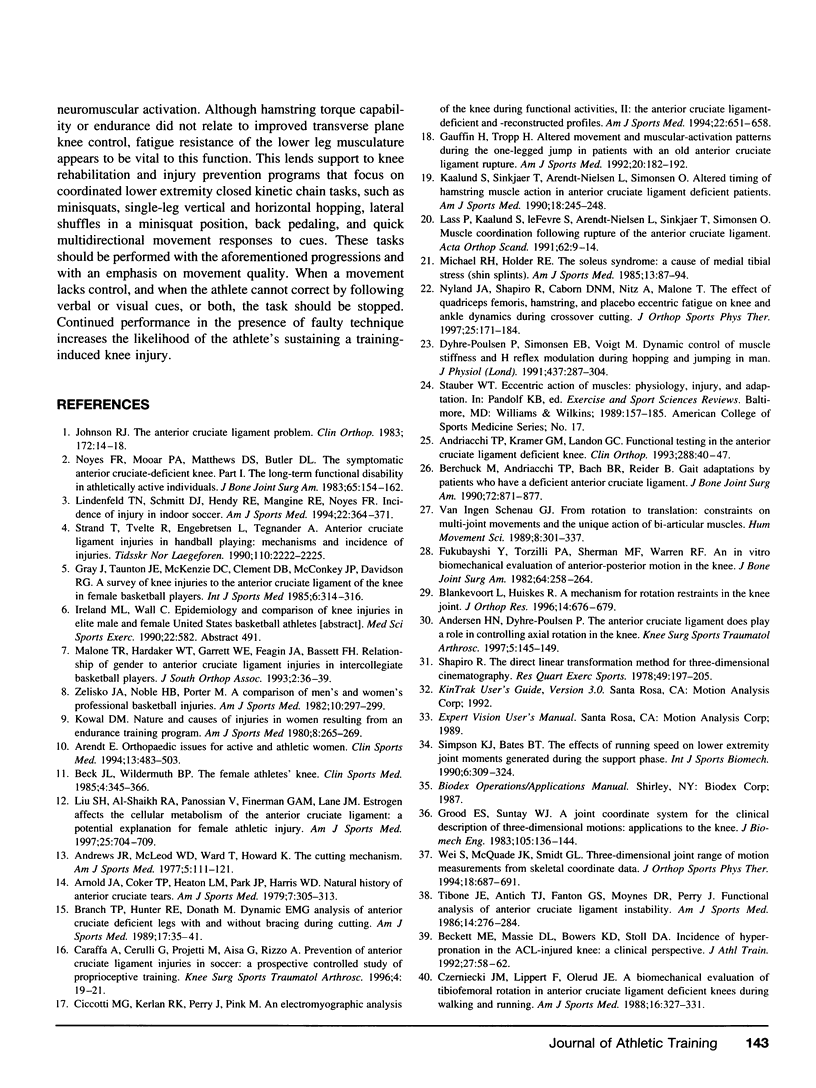
Images in this article
Selected References
These references are in PubMed. This may not be the complete list of references from this article.
- Andersen H. N., Dyhre-Poulsen P. The anterior cruciate ligament does play a role in controlling axial rotation in the knee. Knee Surg Sports Traumatol Arthrosc. 1997;5(3):145–149. doi: 10.1007/s001670050042. [DOI] [PubMed] [Google Scholar]
- Andrews J. R., McLeod W. D., Ward T., Howard K. The cutting mechanism. Am J Sports Med. 1977 May-Jun;5(3):111–121. doi: 10.1177/036354657700500303. [DOI] [PubMed] [Google Scholar]
- Andriacchi T. P., Birac D. Functional testing in the anterior cruciate ligament-deficient knee. Clin Orthop Relat Res. 1993 Mar;(288):40–47. [PubMed] [Google Scholar]
- Arendt E. A. Orthopaedic issues for active and athletic women. Clin Sports Med. 1994 Apr;13(2):483–503. [PubMed] [Google Scholar]
- Arnold J. A., Coker T. P., Heaton L. M., Park J. P., Harris W. D. Natural history of anterior cruciate tears. Am J Sports Med. 1979 Nov-Dec;7(6):305–313. doi: 10.1177/036354657900700601. [DOI] [PubMed] [Google Scholar]
- Beck J. L., Wildermuth B. P. The female athlete's knee. Clin Sports Med. 1985 Apr;4(2):345–366. [PubMed] [Google Scholar]
- Beckett M. E., Massie D. L., Bowers K. D., Stoll D. A. Incidence of Hyperpronation in the ACL Injured Knee: A Clinical Perspective. J Athl Train. 1992;27(1):58–62. [PMC free article] [PubMed] [Google Scholar]
- Berchuck M., Andriacchi T. P., Bach B. R., Reider B. Gait adaptations by patients who have a deficient anterior cruciate ligament. J Bone Joint Surg Am. 1990 Jul;72(6):871–877. [PubMed] [Google Scholar]
- Blankevoort L., Huiskes R. A mechanism for rotation restraints in the knee joint. J Orthop Res. 1996 Jul;14(4):676–679. doi: 10.1002/jor.1100140425. [DOI] [PubMed] [Google Scholar]
- Branch T. P., Hunter R., Donath M. Dynamic EMG analysis of anterior cruciate deficient legs with and without bracing during cutting. Am J Sports Med. 1989 Jan-Feb;17(1):35–41. doi: 10.1177/036354658901700106. [DOI] [PubMed] [Google Scholar]
- Caraffa A., Cerulli G., Projetti M., Aisa G., Rizzo A. Prevention of anterior cruciate ligament injuries in soccer. A prospective controlled study of proprioceptive training. Knee Surg Sports Traumatol Arthrosc. 1996;4(1):19–21. doi: 10.1007/BF01565992. [DOI] [PubMed] [Google Scholar]
- Ciccotti M. G., Kerlan R. K., Perry J., Pink M. An electromyographic analysis of the knee during functional activities. II. The anterior cruciate ligament-deficient and -reconstructed profiles. Am J Sports Med. 1994 Sep-Oct;22(5):651–658. doi: 10.1177/036354659402200513. [DOI] [PubMed] [Google Scholar]
- Czerniecki J. M., Lippert F., Olerud J. E. A biomechanical evaluation of tibiofemoral rotation in anterior cruciate deficient knees during walking and running. Am J Sports Med. 1988 Jul-Aug;16(4):327–331. doi: 10.1177/036354658801600403. [DOI] [PubMed] [Google Scholar]
- Dyhre-Poulsen P., Simonsen E. B., Voigt M. Dynamic control of muscle stiffness and H reflex modulation during hopping and jumping in man. J Physiol. 1991 Jun;437:287–304. doi: 10.1113/jphysiol.1991.sp018596. [DOI] [PMC free article] [PubMed] [Google Scholar]
- Fukubayashi T., Torzilli P. A., Sherman M. F., Warren R. F. An in vitro biomechanical evaluation of anterior-posterior motion of the knee. Tibial displacement, rotation, and torque. J Bone Joint Surg Am. 1982 Feb;64(2):258–264. [PubMed] [Google Scholar]
- Gauffin H., Tropp H. Altered movement and muscular-activation patterns during the one-legged jump in patients with an old anterior cruciate ligament rupture. Am J Sports Med. 1992 Mar-Apr;20(2):182–192. doi: 10.1177/036354659202000215. [DOI] [PubMed] [Google Scholar]
- Gray J., Taunton J. E., McKenzie D. C., Clement D. B., McConkey J. P., Davidson R. G. A survey of injuries to the anterior cruciate ligament of the knee in female basketball players. Int J Sports Med. 1985 Dec;6(6):314–316. doi: 10.1055/s-2008-1025861. [DOI] [PubMed] [Google Scholar]
- Grood E. S., Suntay W. J. A joint coordinate system for the clinical description of three-dimensional motions: application to the knee. J Biomech Eng. 1983 May;105(2):136–144. doi: 10.1115/1.3138397. [DOI] [PubMed] [Google Scholar]
- Johnson R. J. The anterior cruciate ligament problem. Clin Orthop Relat Res. 1983 Jan-Feb;(172):14–18. [PubMed] [Google Scholar]
- Kowal D. M. Nature and causes of injuries in women resulting from an endurance training program. Am J Sports Med. 1980 Jul-Aug;8(4):265–269. doi: 10.1177/036354658000800410. [DOI] [PubMed] [Google Scholar]
- Kålund S., Sinkjaer T., Arendt-Nielsen L., Simonsen O. Altered timing of hamstring muscle action in anterior cruciate ligament deficient patients. Am J Sports Med. 1990 May-Jun;18(3):245–248. doi: 10.1177/036354659001800304. [DOI] [PubMed] [Google Scholar]
- Lass P., Kaalund S., leFevre S., Arendt-Nielsen L., Sinkjaer T., Simonsen O. Muscle coordination following rupture of the anterior cruciate ligament. Electromyographic studies of 14 patients. Acta Orthop Scand. 1991 Feb;62(1):9–14. doi: 10.3109/17453679108993083. [DOI] [PubMed] [Google Scholar]
- Lindenfeld T. N., Schmitt D. J., Hendy M. P., Mangine R. E., Noyes F. R. Incidence of injury in indoor soccer. Am J Sports Med. 1994 May-Jun;22(3):364–371. doi: 10.1177/036354659402200312. [DOI] [PubMed] [Google Scholar]
- Liu S. H., Al-Shaikh R. A., Panossian V., Finerman G. A., Lane J. M. Estrogen affects the cellular metabolism of the anterior cruciate ligament. A potential explanation for female athletic injury. Am J Sports Med. 1997 Sep-Oct;25(5):704–709. doi: 10.1177/036354659702500521. [DOI] [PubMed] [Google Scholar]
- Michael R. H., Holder L. E. The soleus syndrome. A cause of medial tibial stress (shin splints). Am J Sports Med. 1985 Mar-Apr;13(2):87–94. doi: 10.1177/036354658501300202. [DOI] [PubMed] [Google Scholar]
- Noyes F. R., Mooar P. A., Matthews D. S., Butler D. L. The symptomatic anterior cruciate-deficient knee. Part I: the long-term functional disability in athletically active individuals. J Bone Joint Surg Am. 1983 Feb;65(2):154–162. doi: 10.2106/00004623-198365020-00003. [DOI] [PubMed] [Google Scholar]
- Nyland J. A., Shapiro R., Caborn D. N., Nitz A. J., Malone T. R. The effect of quadriceps femoris, hamstring, and placebo eccentric fatigue on knee and ankle dynamics during crossover cutting. J Orthop Sports Phys Ther. 1997 Mar;25(3):171–184. doi: 10.2519/jospt.1997.25.3.171. [DOI] [PubMed] [Google Scholar]
- Shapiro R. Direct linear transformation method for three-dimensional cinematography. Res Q. 1978 May;49(2):197–205. [PubMed] [Google Scholar]
- Tibone J. E., Antich T. J., Fanton G. S., Moynes D. R., Perry J. Functional analysis of anterior cruciate ligament instability. Am J Sports Med. 1986 Jul-Aug;14(4):276–284. doi: 10.1177/036354658601400406. [DOI] [PubMed] [Google Scholar]
- Wei S. H., McQuade K. J., Smidt G. L. Three-dimensional joint range of motion measurements from skeletal coordinate data. J Orthop Sports Phys Ther. 1993 Dec;18(6):687–691. doi: 10.2519/jospt.1993.18.6.687. [DOI] [PubMed] [Google Scholar]
- Zelisko J. A., Noble H. B., Porter M. A comparison of men's and women's professional basketball injuries. Am J Sports Med. 1982 Sep-Oct;10(5):297–299. doi: 10.1177/036354658201000507. [DOI] [PubMed] [Google Scholar]





